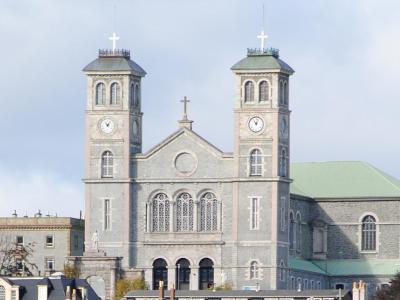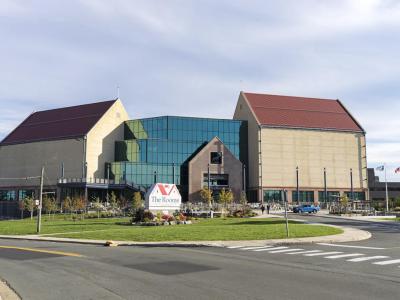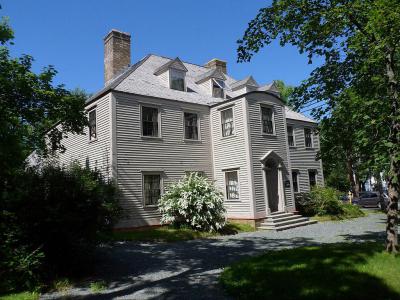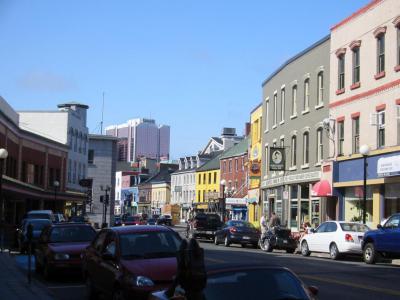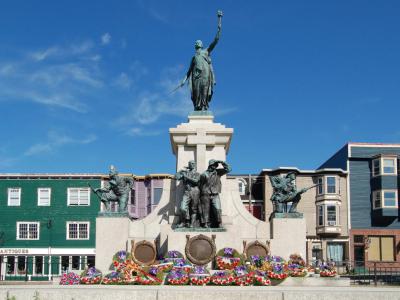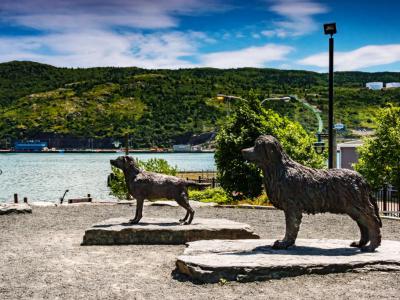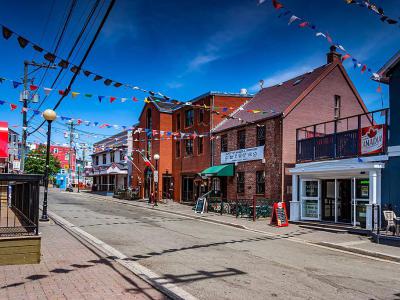St. John's Introduction Walking Tour (Self Guided), St. John`s
The charming capital of Newfoundland, the city of St John's rises on hillsides on the easternmost tip of the island overlooking one of the world's finest natural harbors. The spectacular setting complete with its storied past has shaped this city into a prime tourist spot.
One of the oldest cities founded by Europeans in North America, St John's traces its origins back to the seasonal camps set up by Basque fishermen around the early 1500s. The city owes its name to Venetian explorer John Cabot, who, along with his son, Sebastian, sailed into its harbor on June 24, 1494, the feast day of Saint John the Baptist.
In the 16th century, Portuguese, French, Spanish, and English boats frequented the area for fishing. The town's first defenses emerged due to commerce, and its history includes clashes with the Dutch and the French.
The 18th century brought changes like population growth, government establishment, and fisheries development. Notably, the town played a key role during the Seven Years' War and served as a naval base in the American Revolutionary War and the War of 1812.
St John's faced major fires during the 1800s, with the Great Fire of 1892 being the most renowned incident.
Italian innovator Guglielmo Marconi's groundbreaking wireless signal was received here in 1901, and the city marked the beginning of the first non-stop transatlantic aircraft flight in 1919.
During World War II, St John's supported naval and air force bases. The collapse of the cod fishery in the 1990s had a profound impact, but an economic surge tied to oil fields reinvigorated the city. Many of St John's tourist attractions relate to its long and interesting history.
If you're captivated by things of the past, culture, and picturesque landscapes, a visit to St John's should definitely be on your list. Immerse yourself in local culture at The Rooms, and take in the beauty of the colorful Jellybean Row Houses. Don't miss the chance to pay your respects at the Newfoundland National Memorial and enjoy the vibrant atmosphere of George Street.
St John's offers a unique blend of tradition and modernity, making it a destination that truly has something for everyone. So why wait? Plan your trip to St John's today and create unforgettable memories in this charming and historically rich place!
One of the oldest cities founded by Europeans in North America, St John's traces its origins back to the seasonal camps set up by Basque fishermen around the early 1500s. The city owes its name to Venetian explorer John Cabot, who, along with his son, Sebastian, sailed into its harbor on June 24, 1494, the feast day of Saint John the Baptist.
In the 16th century, Portuguese, French, Spanish, and English boats frequented the area for fishing. The town's first defenses emerged due to commerce, and its history includes clashes with the Dutch and the French.
The 18th century brought changes like population growth, government establishment, and fisheries development. Notably, the town played a key role during the Seven Years' War and served as a naval base in the American Revolutionary War and the War of 1812.
St John's faced major fires during the 1800s, with the Great Fire of 1892 being the most renowned incident.
Italian innovator Guglielmo Marconi's groundbreaking wireless signal was received here in 1901, and the city marked the beginning of the first non-stop transatlantic aircraft flight in 1919.
During World War II, St John's supported naval and air force bases. The collapse of the cod fishery in the 1990s had a profound impact, but an economic surge tied to oil fields reinvigorated the city. Many of St John's tourist attractions relate to its long and interesting history.
If you're captivated by things of the past, culture, and picturesque landscapes, a visit to St John's should definitely be on your list. Immerse yourself in local culture at The Rooms, and take in the beauty of the colorful Jellybean Row Houses. Don't miss the chance to pay your respects at the Newfoundland National Memorial and enjoy the vibrant atmosphere of George Street.
St John's offers a unique blend of tradition and modernity, making it a destination that truly has something for everyone. So why wait? Plan your trip to St John's today and create unforgettable memories in this charming and historically rich place!
How it works: Download the app "GPSmyCity: Walks in 1K+ Cities" from Apple App Store or Google Play Store to your mobile phone or tablet. The app turns your mobile device into a personal tour guide and its built-in GPS navigation functions guide you from one tour stop to next. The app works offline, so no data plan is needed when traveling abroad.
St. John's Introduction Walking Tour Map
Guide Name: St. John's Introduction Walking Tour
Guide Location: Canada » St. John`s (See other walking tours in St. John`s)
Guide Type: Self-guided Walking Tour (Sightseeing)
# of Attractions: 9
Tour Duration: 2 Hour(s)
Travel Distance: 3.9 Km or 2.4 Miles
Author: DanaOffice
Sight(s) Featured in This Guide:
Guide Location: Canada » St. John`s (See other walking tours in St. John`s)
Guide Type: Self-guided Walking Tour (Sightseeing)
# of Attractions: 9
Tour Duration: 2 Hour(s)
Travel Distance: 3.9 Km or 2.4 Miles
Author: DanaOffice
Sight(s) Featured in This Guide:
- Basilica of St. John the Baptist
- The Rooms
- Jellybean Row Houses
- Commissariat House
- Terry Fox Monument
- Water Street
- Newfoundland National Memorial
- Harbourside Park
- George Street
1) Basilica of St. John the Baptist
The Basilica of Saint John the Baptist is a significant religious landmark. It serves as the metropolitan cathedral of the Roman Catholic Archdiocese of Saint John's and is considered the mother church and a symbol of Roman Catholicism in Newfoundland. It is also recognized as a National Historic District of Canada.
The construction of the Basilica-Cathedral was a monumental undertaking and the largest building project in Newfoundland's history at the time. The construction began with the excavation of the ground in May 1839 and progressed steadily until the laying of the cornerstone in May 1841. The arduous process lasted several years and concluded with the completion and consecration of the basilica on September 9, 1855. Notably, it was the largest church building in North America during that era and continues to be the second largest church in Canada, surpassed only by Saint Joseph's Oratory in Montreal. Furthermore, it holds the distinction of being the largest cathedral church in Canada.
The Basilica-Cathedral of Saint John the Baptist has a rich history, having endured significant challenges. It is one of the few structures in Saint John's to have survived the devastating Great Fire of 1892, which ravaged much of the city. This resilience further emphasizes the importance and significance of the basilica as a historical and religious monument.
The Basilica Museum, situated within the Episcopal Library adjacent to the Archbishop's Palace, welcomes visitors seasonally. It offers a fascinating collection of exhibits showcasing religious art, historical and religious artifacts related to the Basilica, portraits of bishops and archbishops of Saint John's, as well as furniture and decorations from various period rooms within the Palace.
The construction of the Basilica-Cathedral was a monumental undertaking and the largest building project in Newfoundland's history at the time. The construction began with the excavation of the ground in May 1839 and progressed steadily until the laying of the cornerstone in May 1841. The arduous process lasted several years and concluded with the completion and consecration of the basilica on September 9, 1855. Notably, it was the largest church building in North America during that era and continues to be the second largest church in Canada, surpassed only by Saint Joseph's Oratory in Montreal. Furthermore, it holds the distinction of being the largest cathedral church in Canada.
The Basilica-Cathedral of Saint John the Baptist has a rich history, having endured significant challenges. It is one of the few structures in Saint John's to have survived the devastating Great Fire of 1892, which ravaged much of the city. This resilience further emphasizes the importance and significance of the basilica as a historical and religious monument.
The Basilica Museum, situated within the Episcopal Library adjacent to the Archbishop's Palace, welcomes visitors seasonally. It offers a fascinating collection of exhibits showcasing religious art, historical and religious artifacts related to the Basilica, portraits of bishops and archbishops of Saint John's, as well as furniture and decorations from various period rooms within the Palace.
2) The Rooms (must see)
The Rooms is a remarkable cultural facility located in St. John's. Established in 2005, it stands proudly on a hill overlooking the picturesque port city, occupying a historic site once occupied by Fort Townshend. The building's name and architecture pay homage to the traditional gable-roofed sheds known as "fishing rooms," which were once a common sight in Newfoundland fishing villages.
This multi-purpose facility is home to three distinct institutions: the Art Gallery of Newfoundland and Labrador, the Provincial Archives of Newfoundland and Labrador, and the Provincial Museum of Newfoundland and Labrador. It serves as a hub for preserving and showcasing the rich cultural heritage of the province.
However, the construction of The Rooms was not without controversy. Archaeologists and historians raised concerns about its location due to the historical significance of the site. Previously, the area housed Fort Townshend, an 18th-century military fort that was eventually buried underground. This sprawling star-shaped citadel, one of the largest British fortifications in North America at the time, was initially built to safeguard Britain's fishing interests. After the departure of the imperial garrison in 1870, the site became home to the Royal Newfoundland Constabulary and later the St. John's Fire Department.
Recognizing the historical importance of the site, it was designated as a National Historic Site of Canada in 1951. To address these concerns and honor the past, the planning and construction of The Rooms involved careful research and documentation, ensuring that future study of the site would be possible.
This multi-purpose facility is home to three distinct institutions: the Art Gallery of Newfoundland and Labrador, the Provincial Archives of Newfoundland and Labrador, and the Provincial Museum of Newfoundland and Labrador. It serves as a hub for preserving and showcasing the rich cultural heritage of the province.
However, the construction of The Rooms was not without controversy. Archaeologists and historians raised concerns about its location due to the historical significance of the site. Previously, the area housed Fort Townshend, an 18th-century military fort that was eventually buried underground. This sprawling star-shaped citadel, one of the largest British fortifications in North America at the time, was initially built to safeguard Britain's fishing interests. After the departure of the imperial garrison in 1870, the site became home to the Royal Newfoundland Constabulary and later the St. John's Fire Department.
Recognizing the historical importance of the site, it was designated as a National Historic Site of Canada in 1951. To address these concerns and honor the past, the planning and construction of The Rooms involved careful research and documentation, ensuring that future study of the site would be possible.
3) Jellybean Row Houses
The Jellybean Row Houses are a charming and iconic feature of St. John's, known for their vibrant colors and picturesque appeal. As one of the first sights to greet visitors, these houses create a whimsical and cheerful atmosphere throughout the city.
The Jellybean Row Houses get their name from their vibrant and varied color palette. Each house is uniquely painted in shades of blue, white, yellow, red, purple, and other eye-catching hues. The result is a kaleidoscope of colors that brings life and character to the streets of St. John's.
The origins of the Jellybean Row Houses can be traced back to the 1970s when a redevelopment initiative took place in the city. As part of this initiative, the houses in the area were painted in vibrant colors to add a touch of liveliness and charm to the neighborhood. The trend quickly caught on, and the residents embraced it, transforming the streets into a visual spectacle.
One of the joys of visiting St. John's is taking a leisurely stroll along the hilly streets, discovering the most beautiful rows of Jellybean Houses.
Wandering through the streets, you'll find yourself immersed in a captivating display of architectural diversity and color. Each house has its own unique charm, and the combination of the various hues creates a delightful and harmonious streetscape. The Jellybean Row Houses have become an iconic symbol of St. John's, capturing the city's vibrant spirit and artistic flair.
The Jellybean Row Houses get their name from their vibrant and varied color palette. Each house is uniquely painted in shades of blue, white, yellow, red, purple, and other eye-catching hues. The result is a kaleidoscope of colors that brings life and character to the streets of St. John's.
The origins of the Jellybean Row Houses can be traced back to the 1970s when a redevelopment initiative took place in the city. As part of this initiative, the houses in the area were painted in vibrant colors to add a touch of liveliness and charm to the neighborhood. The trend quickly caught on, and the residents embraced it, transforming the streets into a visual spectacle.
One of the joys of visiting St. John's is taking a leisurely stroll along the hilly streets, discovering the most beautiful rows of Jellybean Houses.
Wandering through the streets, you'll find yourself immersed in a captivating display of architectural diversity and color. Each house has its own unique charm, and the combination of the various hues creates a delightful and harmonious streetscape. The Jellybean Row Houses have become an iconic symbol of St. John's, capturing the city's vibrant spirit and artistic flair.
4) Commissariat House
Commissariat House is a historic building that showcases the region's rich history. Constructed in the early 19th century, it served as the residence and office for the Assistant Commissary General, overseeing the supply operations for the British forces in Newfoundland. Beyond its administrative role, the house provides a glimpse into the social and political climate of St. John's during the 1830s, a time when discussions of self-governance were taking place.
Today, visitors can explore the house and experience life in that transformative era. The authentic period furnishings and artifacts transport visitors back to the 1830s, offering insights into the challenges faced by the British forces and the changing dynamics of Newfoundland society.
Commissariat House serves as a living history museum, preserving the heritage and reminding visitors of the resilience and determination of the people of St. John's. A visit to Commissariat House provides an immersive and educational experience, allowing visitors to connect with the past and gain a deeper appreciation for the history of the region.
Today, visitors can explore the house and experience life in that transformative era. The authentic period furnishings and artifacts transport visitors back to the 1830s, offering insights into the challenges faced by the British forces and the changing dynamics of Newfoundland society.
Commissariat House serves as a living history museum, preserving the heritage and reminding visitors of the resilience and determination of the people of St. John's. A visit to Commissariat House provides an immersive and educational experience, allowing visitors to connect with the past and gain a deeper appreciation for the history of the region.
5) Terry Fox Monument
The Terry Fox Memorial in St. John's commemorates Terry Fox's iconic Marathon of Hope, where he ran across Canada to raise funds for cancer research. The memorial, located in a small park behind the Port Authority Building, features a bronze statue of Fox dipping his prosthetic foot into the Atlantic Ocean, symbolizing the start of his journey. The memorial was dedicated on the 32nd anniversary of the Marathon of Hope, with Fox's family in attendance.
While the statue serves as a material connection to Fox's remarkable journey and aims to inspire future generations, it raises concerns about Fox's own wishes. Throughout his marathon, Fox emphasized that he did not seek personal fame or recognition but rather aimed to raise money to help those in need. The substantial cost of building the statue, approximately $450,000, could have been directed towards cancer research instead. Fox's views during his lifetime suggest he might have preferred funds to be allocated differently.
However, the statue does not diminish the significance of Fox's accomplishments and his impact on cancer research. It allows people to visually connect with one of Canada's greatest figures and serves as a reminder of his dedication and generosity. The memorial, along with annual Terry Fox runs and other dedications across the country, continues to inspire individuals to pursue their goals and make a positive difference. Ultimately, the statue serves as a testament to Terry Fox's legacy, even though alternative ways of memorializing him may have been more aligned with his own values.
While the statue serves as a material connection to Fox's remarkable journey and aims to inspire future generations, it raises concerns about Fox's own wishes. Throughout his marathon, Fox emphasized that he did not seek personal fame or recognition but rather aimed to raise money to help those in need. The substantial cost of building the statue, approximately $450,000, could have been directed towards cancer research instead. Fox's views during his lifetime suggest he might have preferred funds to be allocated differently.
However, the statue does not diminish the significance of Fox's accomplishments and his impact on cancer research. It allows people to visually connect with one of Canada's greatest figures and serves as a reminder of his dedication and generosity. The memorial, along with annual Terry Fox runs and other dedications across the country, continues to inspire individuals to pursue their goals and make a positive difference. Ultimately, the statue serves as a testament to Terry Fox's legacy, even though alternative ways of memorializing him may have been more aligned with his own values.
6) Water Street
As the oldest main street in North America, the Water Street has borne witness to the evolution of a city, standing as a living testament to the spirit of a community that thrives on its historical roots.
What began as a simple pathway for intrepid explorers and resolute settlers has transformed into a bustling hub of commerce and culture, proudly retaining its position as the commercial heart of St. John's. In the shadows of its cobblestone streets, a tapestry of history unfolds, showcasing the convergence of sailors from across the globe and serving as a gateway to the transatlantic journeys that bring cruise ships to dock nearby.
The historic district of Water Street pays homage to the past, with 19th-century buildings standing as enduring guardians of time. Among these architectural relics, the Murray Premises stand tall, a mercantile marvel that has weathered the storms of time. Erected in 1846, this edifice once served as a bastion of trade and fishing commerce. Remarkably, it emerged unscathed from the fire that swept through the city in 1892, a testament to its endurance. Today, the Murray Premises is not only a National Historic Site but a thriving space housing shops and a hotel, marrying the echoes of history with modern vitality.
Wandering along the cobblestones of Water Street, one encounters the tranquil expanse of Harbourside Park. Here, benches invite contemplation as ships glide by, while intermittent summer performances infuse the air with artistic energy. Statues of two iconic canine breeds, the Newfoundland and Labrador Retriever, pay tribute to the province's cherished companions, adding a touch of whimsy to the maritime atmosphere.
Nestled within the embrace of Water Street is the Railway Coastal Museum, an homage to Newfoundland's evolving transportation legacy. Housed within the historic Newfoundland Railway station, this museum invites visitors to delve into the intricate web of land and sea connections that have shaped the province's identity.
What began as a simple pathway for intrepid explorers and resolute settlers has transformed into a bustling hub of commerce and culture, proudly retaining its position as the commercial heart of St. John's. In the shadows of its cobblestone streets, a tapestry of history unfolds, showcasing the convergence of sailors from across the globe and serving as a gateway to the transatlantic journeys that bring cruise ships to dock nearby.
The historic district of Water Street pays homage to the past, with 19th-century buildings standing as enduring guardians of time. Among these architectural relics, the Murray Premises stand tall, a mercantile marvel that has weathered the storms of time. Erected in 1846, this edifice once served as a bastion of trade and fishing commerce. Remarkably, it emerged unscathed from the fire that swept through the city in 1892, a testament to its endurance. Today, the Murray Premises is not only a National Historic Site but a thriving space housing shops and a hotel, marrying the echoes of history with modern vitality.
Wandering along the cobblestones of Water Street, one encounters the tranquil expanse of Harbourside Park. Here, benches invite contemplation as ships glide by, while intermittent summer performances infuse the air with artistic energy. Statues of two iconic canine breeds, the Newfoundland and Labrador Retriever, pay tribute to the province's cherished companions, adding a touch of whimsy to the maritime atmosphere.
Nestled within the embrace of Water Street is the Railway Coastal Museum, an homage to Newfoundland's evolving transportation legacy. Housed within the historic Newfoundland Railway station, this museum invites visitors to delve into the intricate web of land and sea connections that have shaped the province's identity.
7) Newfoundland National Memorial
Standing resolute on St. John's main street, against the backdrop of the iconic old harbor, the Newfoundland National Memorial is a testament to the unwavering spirit and sacrifices of Newfoundlanders during times of global conflict.
Maintained under the careful watch of the Government of Newfoundland and Labrador, the memorial holds a special place in the hearts of all who visit. It commemorates the valiant contributions of Newfoundland in times of war, both on land and at sea. The memorial's significance lies in its representation of key groups that played vital roles during those challenging times: the Royal Newfoundland Regiment, the Royal Naval Reserve, the Mercantile Marine, and the Forestry Corps. These groups are immortalized in lifelike bronze figures that capture their dedication and courage.
Above these figures, a commanding granite pedestal proudly supports a female figure, an embodiment of freedom. In her uplifted hand, she holds a torch, a symbol of hope that pierces through the darkness of conflict. As visitors approach the memorial, they ascend wide stone steps that lead to a semicircular wall of granite, enclosing a sacred space of remembrance. Flowers in stone urns stand as silent witnesses to the past, flanking the path that guides individuals toward the monument. Tall, dignified shade trees have been thoughtfully planted around the dais, creating an atmosphere of reverence and tranquility.
In 2019, the Newfoundland National Memorial was officially designated a National Historic Site, a fitting recognition of its artistic significance and its profound connection to history.
Maintained under the careful watch of the Government of Newfoundland and Labrador, the memorial holds a special place in the hearts of all who visit. It commemorates the valiant contributions of Newfoundland in times of war, both on land and at sea. The memorial's significance lies in its representation of key groups that played vital roles during those challenging times: the Royal Newfoundland Regiment, the Royal Naval Reserve, the Mercantile Marine, and the Forestry Corps. These groups are immortalized in lifelike bronze figures that capture their dedication and courage.
Above these figures, a commanding granite pedestal proudly supports a female figure, an embodiment of freedom. In her uplifted hand, she holds a torch, a symbol of hope that pierces through the darkness of conflict. As visitors approach the memorial, they ascend wide stone steps that lead to a semicircular wall of granite, enclosing a sacred space of remembrance. Flowers in stone urns stand as silent witnesses to the past, flanking the path that guides individuals toward the monument. Tall, dignified shade trees have been thoughtfully planted around the dais, creating an atmosphere of reverence and tranquility.
In 2019, the Newfoundland National Memorial was officially designated a National Historic Site, a fitting recognition of its artistic significance and its profound connection to history.
8) Harbourside Park
The Harbourside Park was thoughtfully constructed opposite the National War Memorial to honor the significant event of Sir Humphrey Gilbert's proclamation in 1583, marking the British claim on Newfoundland. With its rich historical backdrop and captivating features, Harbourside Park has become a cherished gathering place for both locals and visitors alike.
The park's historical significance is anchored in the proclamation made by Sir Humphrey Gilbert, an event that reshaped the course of Newfoundland's history. Despite the initial skepticism of French, Spanish, and Portuguese fishermen present in the port at that time, Gilbert's proclamation laid the foundation for British influence in the region. The irony of this momentous occasion is not lost, as Gilbert's subsequent misfortune, where he ran his ship aground and tragically perished, seemed to confirm the early doubts about his endeavors.
The park features two eye-catching bronze statues, depicting a Newfoundland dog and a Labrador Retriever. These statues offer a playful connection to the region's rich maritime heritage and celebrate the bond between Newfoundlanders and their beloved canine companions. The statues of these iconic dog breeds also serve as inviting seats, inviting both children and adults to rest and enjoy the tranquility of the park.
One of the park's highlights is the City of St. John’s free Music at Harbourside lunchtime concert series, a delightful tradition that takes place every Friday at 12:30 p.m. throughout the summer months. Beyond its musical offerings, Harbourside Park provides a unique vantage point for observing the ebb and flow of the harbor's maritime activity. Watching boats come and go adds a touch of timeless charm to the park experience, creating a sense of connection to the region's maritime roots.
The park's historical significance is anchored in the proclamation made by Sir Humphrey Gilbert, an event that reshaped the course of Newfoundland's history. Despite the initial skepticism of French, Spanish, and Portuguese fishermen present in the port at that time, Gilbert's proclamation laid the foundation for British influence in the region. The irony of this momentous occasion is not lost, as Gilbert's subsequent misfortune, where he ran his ship aground and tragically perished, seemed to confirm the early doubts about his endeavors.
The park features two eye-catching bronze statues, depicting a Newfoundland dog and a Labrador Retriever. These statues offer a playful connection to the region's rich maritime heritage and celebrate the bond between Newfoundlanders and their beloved canine companions. The statues of these iconic dog breeds also serve as inviting seats, inviting both children and adults to rest and enjoy the tranquility of the park.
One of the park's highlights is the City of St. John’s free Music at Harbourside lunchtime concert series, a delightful tradition that takes place every Friday at 12:30 p.m. throughout the summer months. Beyond its musical offerings, Harbourside Park provides a unique vantage point for observing the ebb and flow of the harbor's maritime activity. Watching boats come and go adds a touch of timeless charm to the park experience, creating a sense of connection to the region's maritime roots.
9) George Street (must see)
George Street is a vibrant and lively destination renowned for its thriving bar and pub scene. This small street, spanning only two blocks, is a haven for nightlife enthusiasts and food lovers alike, as it is lined with a variety of bars, pubs, and restaurants.
One notable aspect of George Street is its unique pedestrian-only policy during the evenings and most of the business day. This restriction allows visitors to explore the street freely without worrying about vehicular traffic. However, in the mornings, the street opens briefly to traffic, primarily for the purpose of restocking goods for the bars and pubs that line the street.
While George Street is known for its bustling atmosphere, it typically doesn't get crowded until later in the night, around midnight. The street remains busy into the early morning hours, sometimes as late as 6 a.m., even though the sale of alcohol ceases at a certain point. To cater to hungry partygoers, there are numerous hot dog vendors and 24-hour restaurants conveniently located nearby.
One of the standout events on George Street is the annual Mardi Gras celebration, which takes place in October. This timing might be different from the traditional February festivities observed in other parts of the world, leading to a unique experience for visitors.
Additionally, the highlight of the street's calendar is the George Street Festival, a six-night extravaganza that occurs in early August. This festival, rumored to be the largest of its kind in North America, attracts a staggering 120,000 people over the course of six days. It typically concludes on the Tuesday night before the Royal St. John's Regatta, which occurs on the first Wednesday in August.
One notable aspect of George Street is its unique pedestrian-only policy during the evenings and most of the business day. This restriction allows visitors to explore the street freely without worrying about vehicular traffic. However, in the mornings, the street opens briefly to traffic, primarily for the purpose of restocking goods for the bars and pubs that line the street.
While George Street is known for its bustling atmosphere, it typically doesn't get crowded until later in the night, around midnight. The street remains busy into the early morning hours, sometimes as late as 6 a.m., even though the sale of alcohol ceases at a certain point. To cater to hungry partygoers, there are numerous hot dog vendors and 24-hour restaurants conveniently located nearby.
One of the standout events on George Street is the annual Mardi Gras celebration, which takes place in October. This timing might be different from the traditional February festivities observed in other parts of the world, leading to a unique experience for visitors.
Additionally, the highlight of the street's calendar is the George Street Festival, a six-night extravaganza that occurs in early August. This festival, rumored to be the largest of its kind in North America, attracts a staggering 120,000 people over the course of six days. It typically concludes on the Tuesday night before the Royal St. John's Regatta, which occurs on the first Wednesday in August.
The Most Popular Cities
/ view all



